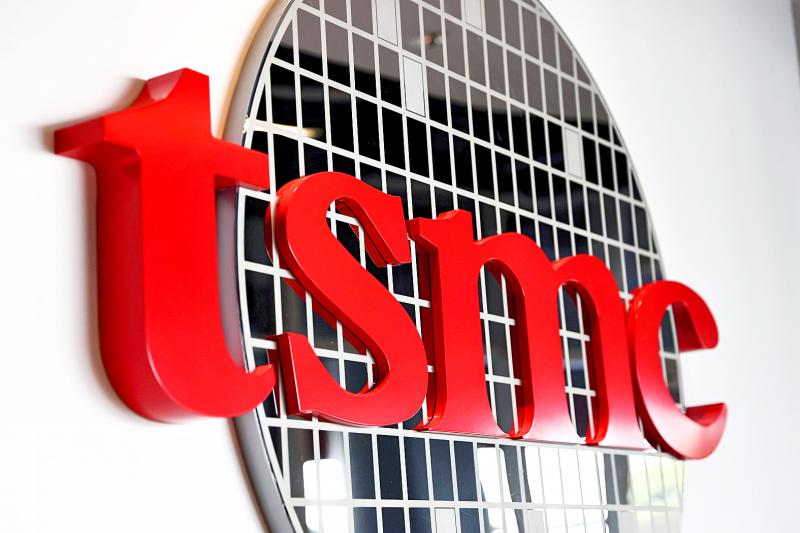Taiwan Semiconductor Manufacturing Co (TSMC, 台積電) is weighing plans to pump tens of billions of dollars more into cutting-edge chip factories in Arizona than it had previously disclosed, but is cool on prospects for an advanced European plant, people familiar with the matter said.
TSMC is the world’s most advanced chipmaker, and its investment plans are being closely watched amid a global chip shortage and new initiatives in the US and Europe to subsidize semiconductor production. TSMC last year announced that it would invest US$10 billion to US$12 billion to build a chip factory in Phoenix.
The previously disclosed factory could be the first of up to six planned plants at the site, according to reports earlier this month.

Photo: Ann Wang, Reuters
Now, company officials are debating whether the next plant should be a more advanced facility that can make chips with so-called 3-nanometer chipmaking technology compared to the slower, less-efficient 5-nanometer technology used for the first factory.
The more advanced 3-nanometer plant could cost US$23 billion to US$25 billion, one person familiar with the matter said.
Details of TSMC’s plans for the additional factories at the Arizona site have not been previously reported.
Officials have also sketched out plans for TSMC to make next-generation 2-nanometer and smaller chips as the Phoenix campus is built out the next 10 to 15 years, the person said.
In building the plants, TSMC is likely to compete against Intel Corp and Samsung Electronics Co for subsides from the US government. President Joe Biden has called for US$50 billion in funding to support domestic chip manufacturing.
Some government officials worry that subsidies for TSMC could help Taiwan, where the company would likely continue to conduct research and development, more than the US. But the US subsidy plan does not exclude foreign firms.
Government and industry officials say a strong domestic chipmaking sector is critical for the economy and national security. Although US chip firms, such as Qualcomm Inc and Nvidia Corp dominate their markets globally, most of their chips are manufactured in Asia.
Intel has also committed to two more new fabrication plants, or fabs, in Arizona, while Samsung is planning a US$17 billion factory adjacent to an existing facility in Austin, Texas.
A debate over how to boost chipmaking is also playing out in the EU. Intel has shown serious interest in those efforts, with chief executive Pat Gelsinger pitching a subsidy that could amount to US$9 billion for a proposed “Eurofab” during a trip to Brussels last month.
European Commissioner for Internal Market Thierry Breton, who has championed the Eurofab idea, also spoke with TSMC Europe president Maria Marced last month. Although Breton publicly called the TSMC talk a “good exchange,” a second person familiar with the matter said the TSMC talks in Europe have gone “very poorly.”
A TSMC spokeswoman said that the company has not ruled out any possibilities, but that there are no plans for a plant in Europe.
European chip and auto companies, for their part, are mostly lined up against the idea. They would prefer subsidies for the older-generation chips that are heavily used by auto manufacturers and are in short supply.
Many of TSMC’s most lucrative customers, such as Apple Inc, are US-based, while its European customer base is made up of mostly automakers buying less-advanced chips. In the first quarter, clients based in Europe and the Middle East only accounted for 6 percent of TSMC’s revenue, far outpaced by the 67 percent of sales from North America and 17 percent from Asia Pacific.
Sources said that TSMC has not ruled out building an older-generation chip plant in Europe to serve auto customers.
TSMC this year hired Benjamin Miller, a 25-year Intel veteran, as its head of human resources in Arizona. The company said that it has hired 250 engineers there and that about 100 of them, along with their families, have been sent to Tainan, where they would complete a 12 to 18-month training program before returning to Arizona.
TSMC declined to comment on specific details of its Arizona plans, but chief executive C.C. Wei (魏哲家) last month said that “further expansion is possible” after an initial phase.
The company would gauge efficiency at the site and customer demand and decide on the next steps, he said.
TSMC founder Morris Chang (張忠謀) last month warned of higher operating costs and a thin talent pool for the US plans in a rare public speech attended by Wei and chairman Mark Liu (劉德音).
“In the United States, the level of professional dedication is no match to that in Taiwan, at least for engineers,” Chang said, warning that “short-term subsidy can’t make up for long-term operational disadvantage.”
TSMC’s first Arizona factory would be relatively small, with a projected output of 20,000 wafers — 12-inch silicon discs that can each contain thousands of chips — per month. By contrast, TSMC’s “gigafabs” in Taiwan can produce 100,000 wafers per month.
TSMC leaders are taking a long view, starting with mature technology and ramping up volume, while gradually introducing the most advanced processes, a third person familiar with the matter said.
“You just don’t go into Phoenix, 10,000 miles away, and start fabricating on the leading edge,” the person said.

CHIP RACE: Three years of overbroad export controls drove foreign competitors to pursue their own AI chips, and ‘cost US taxpayers billions of dollars,’ Nvidia said China has figured out the US strategy for allowing it to buy Nvidia Corp’s H200s and is rejecting the artificial intelligence (AI) chip in favor of domestically developed semiconductors, White House AI adviser David Sacks said, citing news reports. US President Donald Trump on Monday said that he would allow shipments of Nvidia’s H200 chips to China, part of an administration effort backed by Sacks to challenge Chinese tech champions such as Huawei Technologies Co (華為) by bringing US competition to their home market. On Friday, Sacks signaled that he was uncertain about whether that approach would work. “They’re rejecting our chips,” Sacks

Taiwan’s long-term economic competitiveness will hinge not only on national champions like Taiwan Semiconductor Manufacturing Co. (TSMC, 台積電) but also on the widespread adoption of artificial intelligence (AI) and other emerging technologies, a US-based scholar has said. At a lecture in Taipei on Tuesday, Jeffrey Ding, assistant professor of political science at the George Washington University and author of "Technology and the Rise of Great Powers," argued that historical experience shows that general-purpose technologies (GPTs) — such as electricity, computers and now AI — shape long-term economic advantages through their diffusion across the broader economy. "What really matters is not who pioneers

BUBBLE? Only a handful of companies are seeing rapid revenue growth and higher valuations, and it is not enough to call the AI trend a transformation, an analyst said Artificial intelligence (AI) is entering a more challenging phase next year as companies move beyond experimentation and begin demanding clear financial returns from a technology that has delivered big gains to only a small group of early adopters, PricewaterhouseCoopers (PwC) Taiwan said yesterday. Most organizations have been able to justify AI investments through cost recovery or modest efficiency gains, but few have achieved meaningful revenue growth or long-term competitive advantage, the consultancy said in its 2026 AI Business Predictions report. This growing performance gap is forcing executives to reconsider how AI is deployed across their organizations, it said. “Many companies

China Vanke Co (萬科), China’s last major developer to have so far avoided default amid an unprecedented property crisis, has been left with little time to keep debt failure at bay after creditors spurned its proposal to push back a looming bond payment. Once China’s biggest homebuilder by sales, Vanke failed to obtain sufficient support for its plan to delay paying the 2 billion yuan (US$283.51 million) note due today, a filing to the National Association of Financial Market Institutional Investors showed late on Saturday. The proposal, along with two others on the ballot, would have allowed a one-year extension. All three